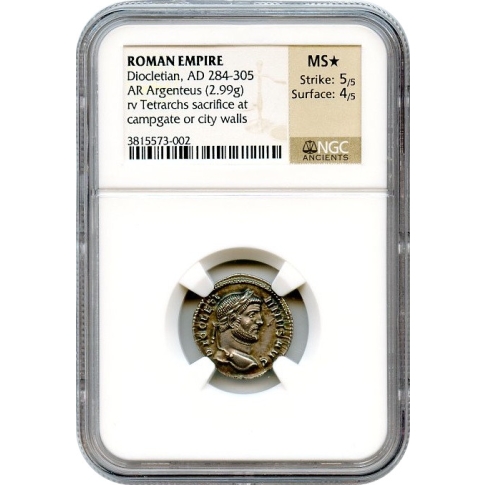Ancient Rome - AD 284-305 Diocletian AR Argenteus NGC MS★ Ex. Robbins Collection
Diocletian, 284-305 CE. AR Argenteus. Siscia Mint, 294-295 CE. Obverse: DIOCLETI-ANVS AVG, laureate head of Diocletian right. Reverse: VIRTVS-MILITVM, four tetrarchs sacrificing over tripod before fortress gate with six towers. RIC VI 43a. Note the razor-sharp strike and details in this mint state piece from over 1,700 years ago. Original mint luster helps this example stand out from the crowd of ancient Roman specimens. Rich golden brown patina with splashes of russet are found on both sides of this truly impressive work of numismatic art. The star awarded by NGC attests to its overall superior quality and eye appeal.

Carved head of Diocletian at Serbia's National Museum. Photo: Wikipedia.
The argenteus (plural argentei, 'of silver') was a silver coin struck by the Roman Empire from the period of Diocletian's coinage reforms of CE 294 until circa CE 310. It was similar in weight and fineness to the denarius of Nero's time. The argenteus was struck at a theoretical weight of 1/96th of a Roman pound (around 3 grams). One gold Aureus was equivalent to 25 Argentei, while one Argenteus equaled 8 Folles. The word Argenteus, which means "of silver" in Latin, was first used in Pliny's Natural History in the phrase "agenteus nummus" (silver coin).
Diocletian (Gaius Aurelius Valerius Diocletianus Augustus), born Diocles (244-312), was Roman emperor from 284 to 305). Born to a poor Dalmatian family, he rose in the military to become commander of the Roman cavalry to emperor Carus. After the death of Carus and his son Numerian on campaign in Persia, Diocletian defeated his other son, Carinus. Diocletian's rule ended the Crisis of the Third Century. Appointing Maximian as co-emperor in 286, Diocletian ruled the Eastern empire while Maximian controlled the Western empire. He secured the empire's borders and removed all threats to his power. Diocletian created a 'tetrarchy' or 'rule of four,' whereby he appointed Galerius and Constantius as Caesars, junior co-emperors, under himself and Maximian. The tetrarchy defeated the many enemies within the empire, as well as Sassanid Persia, Rome's traditional enemy.
He split and enlarged the empire's civil and military services and also reorganized the empire's provinces, thereby creating the biggest, most bureaucratic government in the empire's long history. Third century political culture trends inspired Diocletian towards absolutism, and thus he became an autocrat, placing himself above the citizenry with imposing court ceremonies and architecture. Tax reform was needed due to the growth of bureaucracy and military, endless military campaigns, and massive construction projects. From 297 onward, taxation in the empire was standardized, made more equitable, and raised to higher rates. The Diocletian Persecution (303-11) was the empire's last, biggest and bloodiest persecution of Christians, and it failed to rid Rome of Christianity.
Diocletian was the first person to voluntarily abdicate his office, doing so on May 1, 305. He lived out his retirement at his Dalmatian court palace, where he tended to his vegetable gardens. That palace later on became the center of the modern-day Croatian city of Split.
| Grading Service | NGC |
|---|---|
| Year of Issue | NONE |
| Grade | MS62 |
| Ancient Year Range | 201-300 AD |
| Denom Type | Ancient |
| Numeric Denomination | AR Argenteus |
| Mint Location | NONE |
| Designation | NONE |
| Circ/UnCirc | Uncirculated |
| Strike Type | Business |
| Holder Variety | Strike 5/5; Surface 4/5 |
| Grade Add On | STAR |
| Holder Type | N/A |



